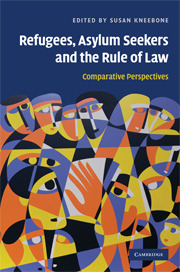Book contents
- Frontmatter
- Contents
- Contributors
- Foreword
- Preface
- Introduction: Refugees and Asylum Seekers in the International Context – Rights and Realities
- 1 The Rule of Law and the Role of Law: Refugees and Asylum Seekers
- 2 Asylum and the Rule of Law in Canada: Hearing the Other (Side)
- 3 Refugees, Asylum and the Rule of Law in the USA
- 4 The Australian Story: Asylum Seekers outside the Law
- 5 The Intersection between the International, the Regional and the Domestic: Seeking Asylum in the UK
- 6 Conclusions on the Rule of Law
- Appendix
- Bibliography
- Index
4 - The Australian Story: Asylum Seekers outside the Law
Published online by Cambridge University Press: 10 December 2009
- Frontmatter
- Contents
- Contributors
- Foreword
- Preface
- Introduction: Refugees and Asylum Seekers in the International Context – Rights and Realities
- 1 The Rule of Law and the Role of Law: Refugees and Asylum Seekers
- 2 Asylum and the Rule of Law in Canada: Hearing the Other (Side)
- 3 Refugees, Asylum and the Rule of Law in the USA
- 4 The Australian Story: Asylum Seekers outside the Law
- 5 The Intersection between the International, the Regional and the Domestic: Seeking Asylum in the UK
- 6 Conclusions on the Rule of Law
- Appendix
- Bibliography
- Index
Summary
Australia achieved international notoriety through its bold handling of the MV Tampa incident in August 2001 and the subsequent creation of the Pacific Plan, which involved extraterritorial processing of asylum seekers. The Tampa incident and its aftermath is possibly the most vivid illustration in this book of the role of law in developing state refugee policy which is contrary to the spirit of the 1951 Convention relating to the Status of Refugees (Refugee Convention) (if not international law). Effectively, this Plan situated the asylum seekers in a legal limbo outside the Australian legal system and prevented them from seeking asylum in Australia. Importantly, the arrangements for the Plan were achieved through the passage of legislation by compliant legislators. This included a law excising parts of Australian territory from the ‘migration zone’ as defined in the Migration Act 1958 (Cth) (Migration Act).
Through the Pacific Plan, Australia successfully denied the asylum seekers access to the national legal system and outsourced its responsibilities under the Refugee Convention. It will be shown in this chapter that the Pacific Plan was the natural outgrowth of restrictive and deterrent policies to refugees which had developed over the previous decade and which demonstrated the power of the executive to drive a legislative agenda to keep asylum seekers apart from the Australian community.
The first part of this chapter describes the history and development of legal responses to refugees and asylum seekers in Australia (including the legislative framework and the constitutional basis of this jurisdiction).
- Type
- Chapter
- Information
- Refugees, Asylum Seekers and the Rule of LawComparative Perspectives, pp. 171 - 227Publisher: Cambridge University PressPrint publication year: 2009
- 2
- Cited by



